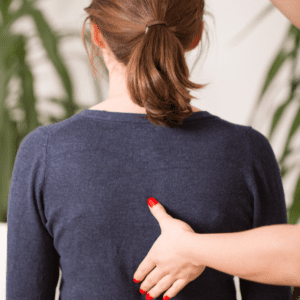Several years ago, while teaching a mat class, one of my newer clients asked, after hearing my unending queues to engage the abdominals: “So, do you walk around all day long sucking your gut in?” My first image was of someone aggressively sucking their gut in to look five pounds thinner or to keep their belly pouch in.
My simple answer was: “Yes, sort of”. I continued to explain that it was not so much “sucking my gut in” but always maintaining some level of muscle engagement in my lower abdominals. I suffered from low back pain off and on for several years, before I discovered Pilates.
Through a solid Pilates regiment, I have either alleviated the low back pain all together, or know how to correct the cause if the pain recurs, by focusing on three basic concepts: alignment, engagement and movement.
ALIGNMENT
Our alignment is critical in reducing pain not only in the low back, but also throughout the body.
How we sit and stand, and how we align our body while doing so, impacts our muscle usage and overall muscle memory. We sit for long periods of time often slouching or leaning to one side. We stand unbalanced with our weight unevenly distributed over our feet. We pop a hip out, we tighten through our neck and shoulders. Over time, we lose our muscle tone that holds us upright. Our muscle memory contorts us to misaligned positions, which become all too “natural”, and are generally the cause of our low back pain.
A quick self-assessment of your body posturing (how you sit, stand and move) will tell us if you are maintaining proper alignment and where we need to focus to reverse any misalignments.

Our goal is to focus on muscle tone that will ensure proper alignment. However, proper alignment will not be sustained without engagement.
ENGAGEMENT
As I mentioned above, throughout my day, I am almost always maintaining some level of engagement. Engaging your muscles properly is key to maintaining proper alignment, thus reducing low back pain. With Pilates, our main focus is building your core strength in order to support your spine, ultimately eliminating low back pain. The stronger the core, particularly the lower abdominals, the easier and more natural the engagement. Implementing the Pilates principle of engagement, i.e., the simple act of engaging my low abdominal muscles, became a very natural practice and has eliminated my low back pain.
Supporting my spine through core engagement, elongates my spine, and helps me maintain overall good alignment. Whether sitting or standing, we want to maintain some level of engagement in our lower abdominals to again, support the low back. However, these same practices must be applied to movement.
MOVEMENT
Applying what we learn in Pilates about alignment and engagement to our daily lives and how we move is key to eliminating or reducing low back pain. Imagine yourself sitting at your computer and working at your desk. Are your low abdominals maintaining some level of engagement? As you begin to feel fatigue, begin to slouch, or arch your back, realign yourself by engaging those low abdominals. Roll the shoulders down away from your ears. Pay attention to how your carry things or how you stand while waiting in lines. Place your weight equally over both feet, engage those abs, and elongate the body. Again, as we fatigue or become “muscle lazy” we lose our alignment and engagement, which more often than not, results in low back pain or discomfort.
Through regular Pilates practice, your alignment, muscle engagement and overall movement will become second nature, ultimately reducing or eliminating low back pain. Through your commitment to Pilates principles and practices, you are better equipped to align, engage and move pain free.
About the author:

Barbara Sferra has always maintained a connection between mind, body, and form. She participated in gymnastics from Jr. High School through College and she took her first dance class at the age of 22 and has been dancing ever since.
She was introduced to Pilates as a means to strengthen her core and improve her overall movement and well-being and completed her Pilates training in August 2008.
Professionally, Barbara has a background in Employee Relations and Training, and gives back to the community through various volunteer activities

